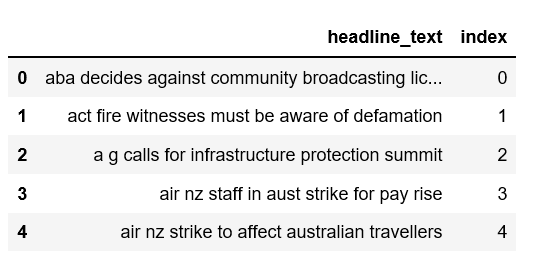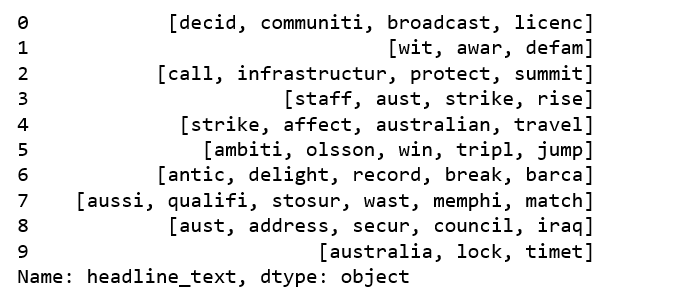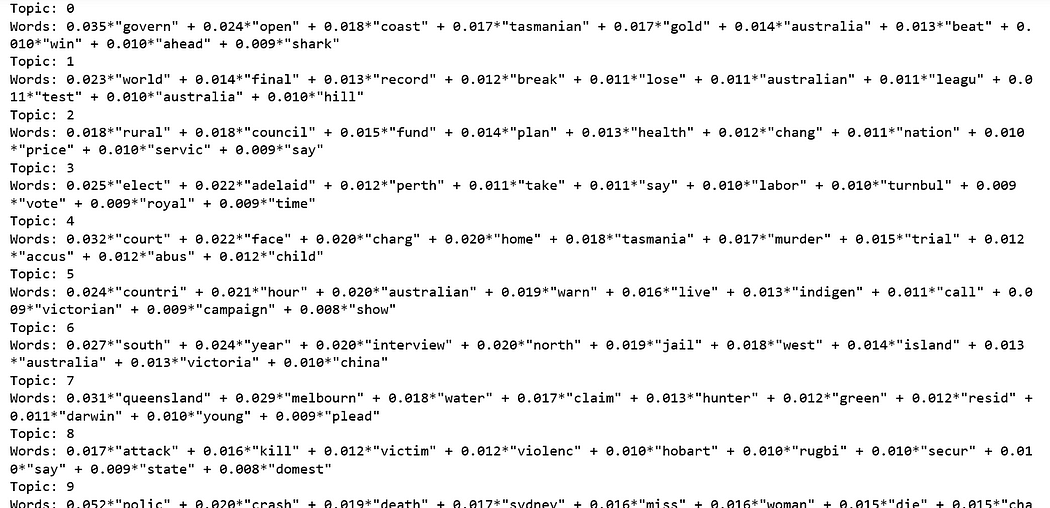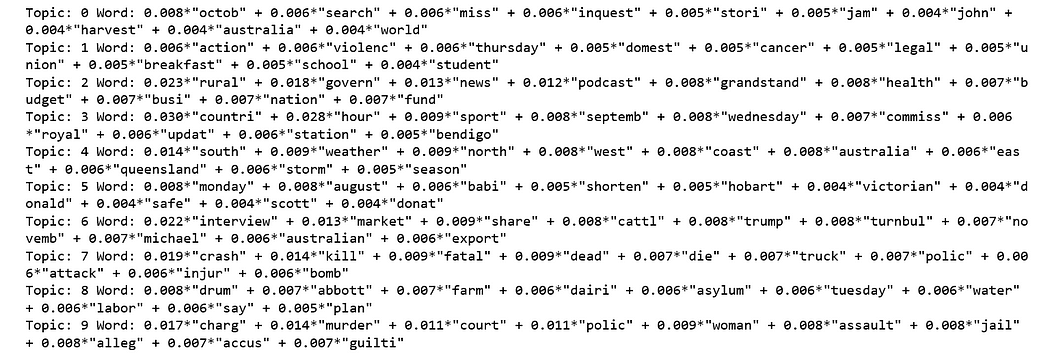Topic Modeling and Latent Dirichlet Allocation (LDA) in Python

Topic modeling is a type of statistical modeling for discovering the abstract “topics” that occur in a collection of documents. Latent Dirichlet Allocation (LDA) is an example of topic model and is used to classify text in a document to a particular topic. It builds a topic per document model and words per topic model, modeled as Dirichlet distributions.
Here we are going to apply LDA to a set of documents and split them into topics. Let’s get started!
The Data
The data set we’ll use is a list of over one million news headlines published over a period of 15 years and can be downloaded from Kaggle.
import pandas as pddata = pd.read_csv('abcnews-date-text.csv', error_bad_lines=False); data_text = data[['headline_text']] data_text['index'] = data_text.index documents = data_text
Take a peek of the data.
print(len(documents))
print(documents[:5])

Data Pre-processing
We will perform the following steps:
- Tokenization: Split the text into sentences and the sentences into words. Lowercase the words and remove punctuation.
- Words that have fewer than 3 characters are removed.
- All stopwords are removed.
- Words are lemmatized — words in third person are changed to first person and verbs in past and future tenses are changed into present.
- Words are stemmed — words are reduced to their root form.
Loading gensim and nltk libraries
import gensim from gensim.utils import simple_preprocess from gensim.parsing.preprocessing import STOPWORDS from nltk.stem import WordNetLemmatizer, SnowballStemmer from nltk.stem.porter import * import numpy as np np.random.seed(2018)import nltk nltk.download('wordnet')
[nltk_data] Downloading package wordnet to[nltk_data] C:\Users\SusanLi\AppData\Roaming\nltk_data…[nltk_data] Package wordnet is already up-to-date!
True
Write a function to perform lemmatize and stem preprocessing steps on the data set.
def lemmatize_stemming(text): return stemmer.stem(WordNetLemmatizer().lemmatize(text, pos='v'))def preprocess(text): result = [] for token in gensim.utils.simple_preprocess(text): if token not in gensim.parsing.preprocessing.STOPWORDS and len(token) > 3: result.append(lemmatize_stemming(token)) return result
Select a document to preview after preprocessing.
doc_sample = documents[documents['index'] == 4310].values[0][0]print('original document: ') words = [] for word in doc_sample.split(' '): words.append(word) print(words) print('\n\n tokenized and lemmatized document: ') print(preprocess(doc_sample))
original document:
[‘rain’, ‘helps’, ‘dampen’, ‘bushfires’]
tokenized and lemmatized document:
[‘rain’, ‘help’, ‘dampen’, ‘bushfir’]
It worked!
Preprocess the headline text, saving the results as ‘processed_docs’
processed_docs = documents[‘headline_text’].map(preprocess)
processed_docs[:10]

Figure 2
Bag of Words on the Data set
Create a dictionary from ‘processed_docs’ containing the number of times a word appears in the training set.
dictionary = gensim.corpora.Dictionary(processed_docs)count = 0 for k, v in dictionary.iteritems(): print(k, v) count += 1 if count > 10: break
0 broadcast
1 communiti
2 decid
3 licenc
4 awar
5 defam
6 wit
7 call
8 infrastructur
9 protect
10 summit
Gensim filter_extremes
Filter out tokens that appear in
- less than 15 documents (absolute number) or
- more than 0.5 documents (fraction of total corpus size, not absolute number).
- after the above two steps, keep only the first 100000 most frequent tokens.
dictionary.filter_extremes(no_below=15, no_above=0.5, keep_n=100000)
Gensim doc2bow
For each document we create a dictionary reporting how many
words and how many times those words appear. Save this to ‘bow_corpus’, then check our selected document earlier.
bow_corpus = [dictionary.doc2bow(doc) for doc in processed_docs]
bow_corpus[4310]
[(76, 1), (112, 1), (483, 1), (3998, 1)]
Preview Bag Of Words for our sample preprocessed document.
bow_doc_4310 = bow_corpus[4310]for i in range(len(bow_doc_4310)): print("Word {} (\"{}\") appears {} time.".format(bow_doc_4310[i][0], dictionary[bow_doc_4310[i][0]], bow_doc_4310[i][1]))
Word 76 (“bushfir”) appears 1 time.
Word 112 (“help”) appears 1 time.
Word 483 (“rain”) appears 1 time.
Word 3998 (“dampen”) appears 1 time.
TF-IDF
Create tf-idf model object using models.TfidfModel on ‘bow_corpus’ and save it to ‘tfidf’, then apply transformation to the entire corpus and call it ‘corpus_tfidf’. Finally we preview TF-IDF scores for our first document.
from gensim import corpora, modelstfidf = models.TfidfModel(bow_corpus) corpus_tfidf = tfidf[bow_corpus]from pprint import pprintfor doc in corpus_tfidf: pprint(doc) break
[(0, 0.5907943557842693),
(1, 0.3900924708457926),
(2, 0.49514546614015836),
(3, 0.5036078441840635)]
Running LDA using Bag of Words
Train our lda model using gensim.models.LdaMulticore and save it to ‘lda_model’
lda_model = gensim.models.LdaMulticore(bow_corpus, num_topics=10, id2word=dictionary, passes=2, workers=2)
For each topic, we will explore the words occuring in that topic and its relative weight.
for idx, topic in lda_model.print_topics(-1):
print('Topic: {} \nWords: {}'.format(idx, topic))

Can you distinguish different topics using the words in each topic and their corresponding weights?
Can you distinguish different topics using the words in each topic and their corresponding weights?
Running LDA using TF-IDF
lda_model_tfidf = gensim.models.LdaMulticore(corpus_tfidf, num_topics=10, id2word=dictionary, passes=2, workers=4)for idx, topic in lda_model_tfidf.print_topics(-1): print('Topic: {} Word: {}'.format(idx, topic))

Again, can you distinguish different topics using the words in each topic and their corresponding weights?
Performance evaluation by classifying sample document using LDA Bag of Words model
We will check where our test document would be classified.
processed_docs[4310]
[‘rain’, ‘help’, ‘dampen’, ‘bushfir’]
for index, score in sorted(lda_model[bow_corpus[4310]], key=lambda tup: -1*tup[1]):
print("\nScore: {}\t \nTopic: {}".format(score, lda_model.print_topic(index, 10)))

Our test document has the highest probability to be part of the topic that our model assigned, which is the accurate classification.
Performance evaluation by classifying sample document using LDA TF-IDF model.
for index, score in sorted(lda_model_tfidf[bow_corpus[4310]], key=lambda tup: -1*tup[1]):
print("\nScore: {}\t \nTopic: {}".format(score, lda_model_tfidf.print_topic(index, 10)))

Our test document has the highest probability to be part of the topic that our model assigned, which is the accurate classification.
Testing model on unseen document
unseen_document = 'How a Pentagon deal became an identity crisis for Google' bow_vector = dictionary.doc2bow(preprocess(unseen_document))for index, score in sorted(lda_model[bow_vector], key=lambda tup: -1*tup[1]): print("Score: {}\t Topic: {}".format(score, lda_model.print_topic(index, 5)))

Source code can be found on Github. I look forward to hearing any feedback or questions.
Reference:




